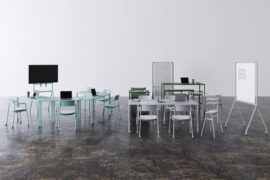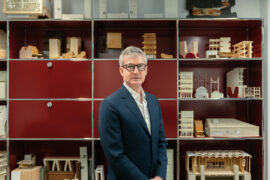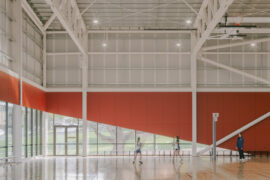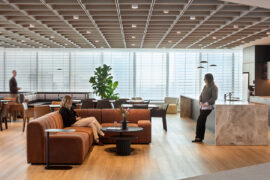Purposefully fluid to provide for different learning environments, Davenport Campbell’s early learning centre is conceptually focused on nurturing a holistic family experience.
Informed by current pedagogical tenets, Davenport Campbell worked directly with all key stakeholders on The Nest Childcare Centre to ensure an impactful environment that would support a new typology in learning. Focusing on an inclusive approach that saw the family as intrinsic to better learning, The Centre effectively functions as an extension of the home environment. As such – and in keeping with commercial shifts that have seen the workplace aesthetic and layout become increasingly residential – Davenport Campbell’s response is far more domestic than the current typology, as Emma Davenport, Davenport Campbell Director and project lead explains: “The home is the environment that a small child is most familiar with, so the design brings cues from home into the childcare environment to make them feel safe and comfortable and enhances the whole experience for child and parent.”

Located within Japanese architect Kengo Kuma’s first Australian building, The Exchange, Darling Square (Australia’s first 6-Star Green Star Community), the building itself is wrapped in a breathtaking circular swirl of sustainably sourced timber. Earning a 6-Star Green Star rating, the interior surfaces are of a high sustainability value, with many design decisions informed to meet this need. Nicknamed ‘The Birds Nest’, the centre caters to ninety children aged six weeks to six years with administrative staff and educators. The two-floor space is the fourth childcare centre Davenport Campbell has designed for The Commonwealth Bank. That said, each centre is a unique and standalone solution that responds directly to the building’s architecture and desired learning environment specific to each operator. Drawing on the concept of bird eggs, the palette is informed by muted blues, greens and peach in soft rounded shapes, with something of the Memphis movement coming into play as the shapes interact. Moreover, it was imperative that overstimulating primary colours be avoided, with current pedagogy stating that muted colours are better for children.

“The whole idea behind the concept is to create contrast, provide colour, texture and pattern as the important things behind the environment for the children, particularly the babies, who are really picking up on contrast and texture.” says Lisa Munao, Davenport Campbell Head of Workplace Design and Innovation. In painting walls and adding graphics with muted colours, the focus remains on what the children are doing. Contrasts of black-and-white checks work with curves and colours and lyrical graphics to deliver an appropriately stimulating environment. “It was very important to not be overwhelming, but provide enough little things – images, colours, patterns and so forth – to prompt the children to engage with this extra world beyond the immediate,” says Davenport. Textural elements play a similar role. Importantly, in an environment where clutter is anathema to the calm learning environment, every element must be primarily selected for its ability to answer functional operational requirements.
 Working with the architect and developer from inception allowed the best possible outcome in terms of light and security. Approaching the round layout as a clock, each space is a segment appropriate to scale and use. “The radial aspect meant all administration and inner workings happen against the core of the building to open all playrooms to as much natural light as possible,” says Munao. In surveying the CBD location, it became apparent that in achieving this scenario security was potentially an issue, as many of the surrounding buildings overlook the building. To obfuscate the ingress of view, Davenport Campbell asked Kuma to reorient the building to afford the same optimisation of light while providing heightened security. Additional security measures were also addressed at this early stage, such as fire escapes, dedicated entries and secure technologies that were embedded and enabled.
Working with the architect and developer from inception allowed the best possible outcome in terms of light and security. Approaching the round layout as a clock, each space is a segment appropriate to scale and use. “The radial aspect meant all administration and inner workings happen against the core of the building to open all playrooms to as much natural light as possible,” says Munao. In surveying the CBD location, it became apparent that in achieving this scenario security was potentially an issue, as many of the surrounding buildings overlook the building. To obfuscate the ingress of view, Davenport Campbell asked Kuma to reorient the building to afford the same optimisation of light while providing heightened security. Additional security measures were also addressed at this early stage, such as fire escapes, dedicated entries and secure technologies that were embedded and enabled.
The glass balustrade, for example, is much higher than normal in the playground area to ensure no Tonka truck missiles find their way to the street. The whole project has in fact been engineered to ensure a highly secure environment, with no potential footholds, handholds or climbing risks.

Led by the circularity of the base build, Davenport Campbell has introduced a new childcare approach whereby a central shared dining space creates an overlap with the home dining space. “The traditional childcare dining experience is changed into a space where lots of different people come together: parents come to spend time with children, and children use it as a learning opportunity where they can participate or watch food being prepared,” says Davenport.
Located on level four, where the older children are cared for, the dining room, while large, is welcoming. Here, the colours are high, with timber panelling, arched servery windows and feature lights conveying a sense of the domestic. Configured to entice movement forward, the space is open on the far side to allow the gaze to travel into the working space and out to the world beyond. More importantly, the role of the room is to provide a shared space for children and parents. Open from 7.30am to 6pm, it effectively gives families an opportunity to spend time together.

“Work and family life is blurred; they’re not two things, they’re integrated or blended with multiple opportunities for quality time. Quality blend time, breakfast, after school – the more time parents get to spend with their kids in this kind of environment the better,” says Davenport.
More of a home away from home than a drop off, the Nest Childcare Centre responds to the fact that the world and how we work has changed. Gender diversity with both parents working is increasingly the norm and this environment nurtures and supports that model. Moreover, the child is at the centre of thinking; their comfort and ease are considered primary to their ability to learn and flourish.
Access the complete issue of Indesign #81, the Education Issue, here.

INDESIGN is on instagram
Follow @indesignlive
A searchable and comprehensive guide for specifying leading products and their suppliers
Keep up to date with the latest and greatest from our industry BFF's!

Welcomed to the Australian design scene in 2024, Kokuyo is set to redefine collaboration, bringing its unique blend of colour and function to individuals and corporations, designed to be used Any Way!

For Aidan Mawhinney, the secret ingredient to Living Edge’s success “comes down to people, product and place.” As the brand celebrates a significant 25-year milestone, it’s that commitment to authentic, sustainable design – and the people behind it all – that continues to anchor its legacy.

Leading by design, Erik L’Heureux has recently taken the helm of Monash University’s Department of Architecture, and so a new and exciting journey begins for both L’Heureux and the University.

Joan Montgomery Centre PLC by Warren and Mahoney is a tour de force of education design, with high-end facilities including a swimming pool and general athletic amenities.
The internet never sleeps! Here's the stuff you might have missed

GroupGSA delivers MUFG Pension & Market Service’s Sydney HQ with a dual Japanese–Australian identity, blending precision, warmth and workplace flexibility.

Guests joined Cosentino for a behind-the-scenes look at The Block homes, discovering new materials and creative partnerships.